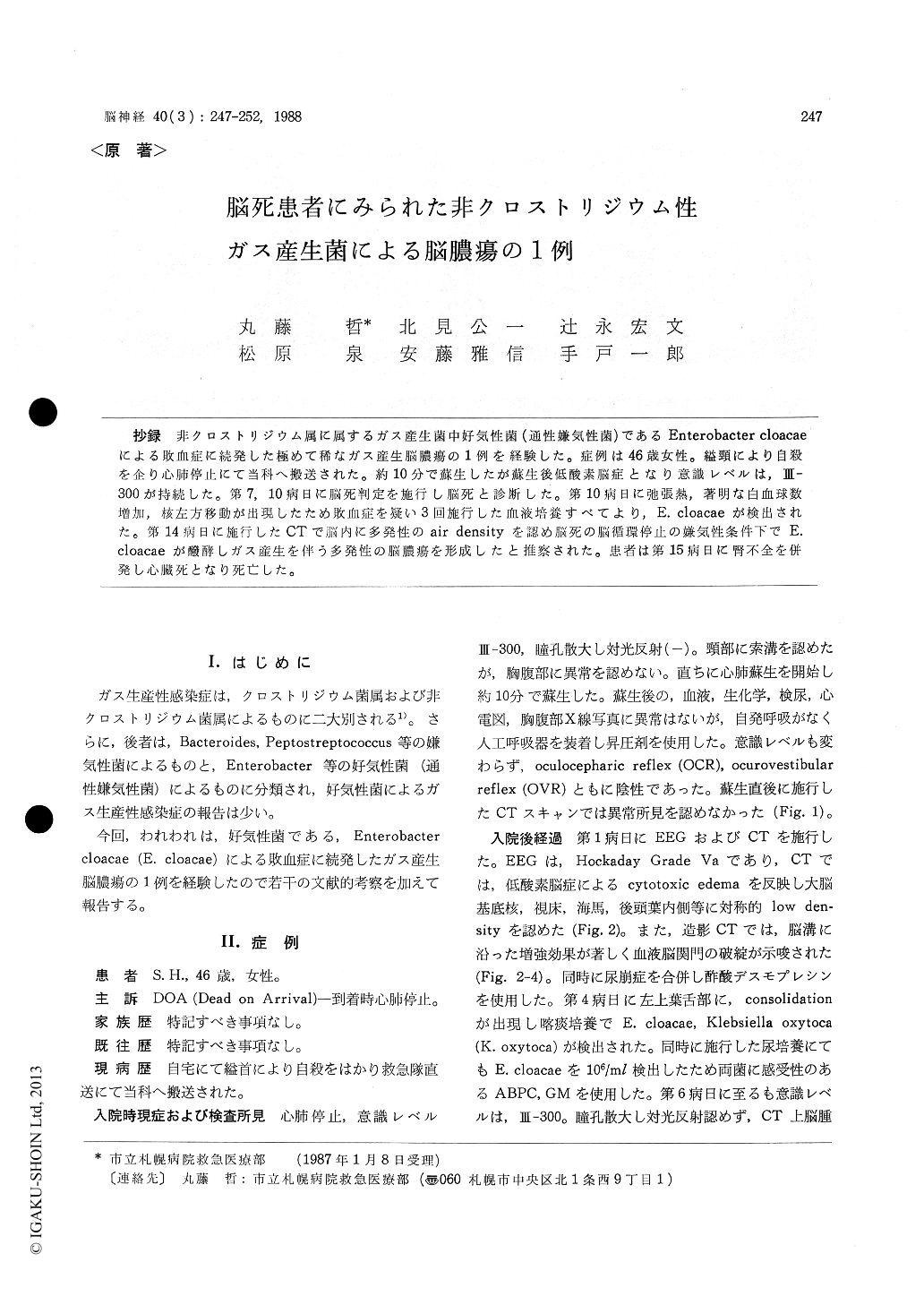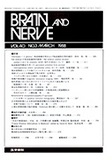Japanese
English
- 有料閲覧
- Abstract 文献概要
- 1ページ目 Look Inside
抄録 非クロストリジウム属に属するガス産生菌中好気性菌(通性嫌気性菌)であるEnterobacter cloacaeによる敗血症に続発した極めて稀なガス産生脳膿瘍の1例を経験した。症例は46歳女性。縊頸により自殺を企り心肺停止にて当科へ搬送された。約10分で蘇生したが蘇生後低酸素脳症となり意識レベルは,III-300が持続した。第7,10病日に脳死判定を施行し脳死と診断した。第10病日に弛張熱,著明な白血球数増加,核左方移動が出現したため敗血症を疑い3回施行した血液培養すべてより,E. cloacaeが検出された。第14病日に施行したCTで脳内に多発性のair densityを認め脳死の脳循環停止の嫌気性条件下でE.cloacaeが醗酵しガス産生を伴う多発性の脳膿瘍を形成したと推察された。患者は第15病日に腎不全を併発し心臓死となり死亡した。
A 46 year old female was admitted to our emergency room because of cardiopulmonary ar-rest by hanging. After ten minutes cardiopulmo-nary resuscitation, she was resuscitated but her consciousness did'nt recover. CT-scans on the day of admission showed no abnormalities but on the second hospital day it showed symmetrical low density areas within the basal ganglia, the tha-lamus, the hippocumpus, and the occipital lobe. There were marked enhanced effect in cerebral sulci due to cytotoxic edema of hypoxic encepha-lopathy.
She was comatose for a week, her pupils were dilated, light reflex and other brain stem reflex were absent. CT-scans on the sixth hospital day showed marked brain swelling with disappearance of the ventricular systems (so called brain tam-ponade). Brain death was confirmed on the basis of Japanese Criteria on the seventh and tenth day of admission.
She had been suffering from pneumonia and urinary tract infection with an elevation of tem-perature since the fourth hospital day. We detect-ed Enterobacter Cloacae (E. Cloacae), Krebsiella Oxytoca from the cultures of sputum and urine. On the tenth hospital day her temperature was running up to 39.4℃ and blood count revealed a peripheral blood leucocytosis of 40.300/mm3 with a shift to the left. E. Cloacae was also detected from the cultures of blood.
Skull roentogenogram showed multiple gas col-lections in the ventricular systems. CT-scans on the fourteenth hospital day showed multiple gas-containing brain abscess. The etiology of this in-fection was considered due to septicemia of E. Cloacae.
She died from acute renal failure on the fif-teenth hospital day. Consent for autopsy was not accepted.
Clostridium species has been considered a re-presentative gas forming infection. It has been pointed out that the incidence of non-clostridial gas-producing infection is increasing in recent years. And non-clostridial species are divided into aerobic and anaerobic organism.
Since 1960, a total of thirty-three cases with gas-containing brain abscess have been reported. However, those due to non-clostridial aerobic organism were only three to our knowlege and this case is thought to be a first one in Japan.
As mentioned above, the etiology of this gas-containing brain abscess was considered due to septicemia of E. Cloacae. E. Cloacae, non-clostri-dial aerobic organism which could ferment glucose to produce acid and gas under anaerobic cir-cumstances like in the dead brain.
Before CT-era solitary intracranial gas with or without air-fluid level were revealed by skull roentogenogram. Recently solitary gas-containing brain abscess with or without ring enhancement could be revealed by CT-scan, but there has no case report with multiple gas-containing brain abscess.

Copyright © 1988, Igaku-Shoin Ltd. All rights reserved.


